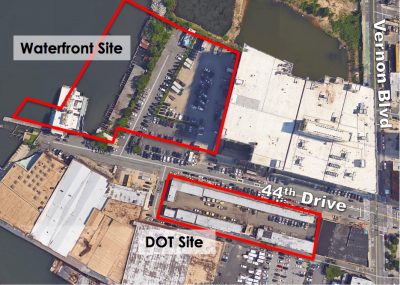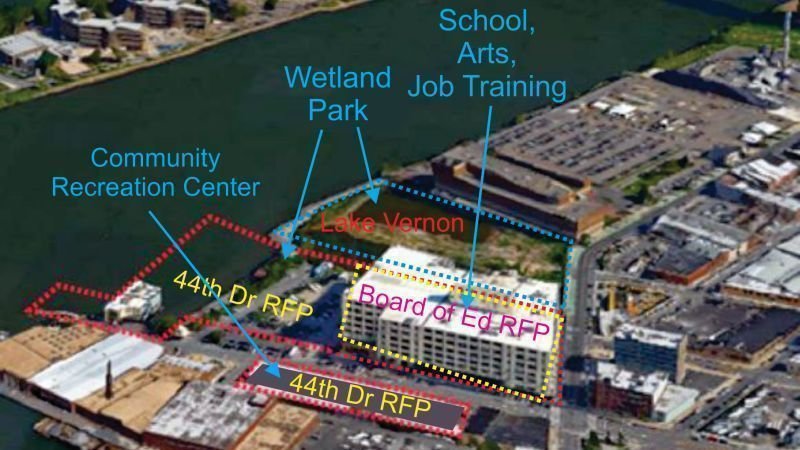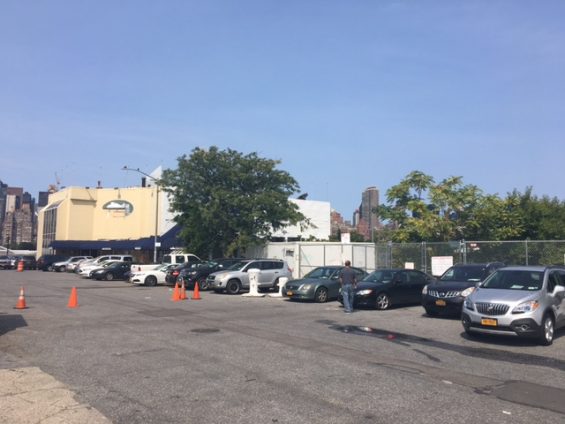
A rendering of the city’s plans for 44th Drive in LIC (via TF Cornerstone)
March 30, 2018 By Nathaly Pesantez
TF Cornerstone, the developer selected to build out the city’s massive and controversial mixed-use project on 44th Drive, says the development is still in its early stages of design, and deals with a lot more than just luxury apartments.
The 1.5 million square-foot project, put forward by the city’s Economic Development Corporation, has been universally panned by the community, most notably for its plan to build nearly 1,000 residential units in two towers on city-owned land.
Civic groups and residents held a rally earlier this month rejecting many aspects of the project. They claim the project is too large, doesn’t feature enough affordable units, and that they were not consulted by the EDC while the concept was being formed.
Elected officials, including Councilmember Jimmy Van Bramer, Assemblymember Cathy Nolan, and State Senator Michael Gianaris, also attended the rally and denounced the project in its current form.
The site needs to be rezoned for the project to move forward. The EDC and TF Cornerstone need Van Bramer’s support for it to proceed.

The two sites slated for development by the EDC.
TF Cornerstone, however, says many of the components the public has been asking for were included as part of the project’s original plan. Furthermore, the design is only about 10 percent complete, he said.
“We were surprised that the community wasn’t more supportive of the overall idea of what the city was trying to accomplish here,” said Jon McMillan, TF Cornerstone’s Director of Planning.
The $925 million plan includes thousands of square feet of industrial and office space, job training, a cultural center, a new public school, and a public park reaching just over an acre. About a quarter of the apartments will be affordable.
“This project is very, very diverse,” said Jon McMillan, TF Cornerstone’s Director of Planning. “It’s not just housing by any means.”
But residents have a different vision for the project site.
The LIC Coalition, which was an organizer of the rally, calls for a recreation center, a wetland park, a school with more seats, an arts facility, and a job training center.

The LIC Coalition’s vision for 44th Drive.
McMillan said the city’s outline for the project makes provisions for many of these requests, while bringing a “live, work, and create” concept to the waterfront. Up until now, most of the waterfront developments have been residential.
The new development, he says, is designed to brings hundreds of jobs and economic activity to the neighborhood through its office and industrial workspaces. which will include spaces with flexible leases for budding companies, and industrial workspaces for a variety of existing businesses, including those in the neighborhood.
The market rate apartments, he adds, are the economic engine that will make the project financially viable.
The Coalition for Queens (C4Q) will be managing about 110,000 square feet of the 400,000 square feet allocated for office space.
C4Q will run a job training center for people interested in pursuing a tech career at the site. The non-profit is known for helping people of low income and diverse backgrounds, and could seek to recruit and train residents at the nearby NYCHA projects, McMillan said.
C4Q will also manage “incubation” and “accelerator” offices spaces, designed for people with business ideas who need a physical office to grow in, and for fast-growing companies that need ever-changing spaces and leases, respectively.
The project will also include 350,000 square feet of “spec office space” that will be offered to a variety of companies from Long Island City and elsewhere. These spaces should further drive economic growth, McMillan said.
Half of the total industrial space for the site, 50,000 square feet, will be run and managed by GMDC. The non-profit will lease spaces out to companies specializing in light industry and technology, like furniture makers, jewelry, and electronic parts manufacturers.
GMDC estimates that one-quarter of the companies on its waiting list for their Brooklyn locations are Long Island City-based, giving them high hopes that the companies heading to the 44th Drive space will be from the neighborhood, according to McMillan. TF Cornerstone is also looking at the possibility of guaranteeing spaces to companies already based in the neighborhood.
Apart from the industrial and office components, the project aligns with other items the community has been calling for, McMillan said. A 600 seat middle school, for example, will be built in an area that has mostly seen elementary schools and high schools. Furthermore, a green, public park with access to the waterfront will also be built, including an indoor space at one of the buildings— a first for the waterfront.
A 20,000 square-foot cultural center with six studios is also in store for the project site. The center would be open to all neighborhood cultural organizations.
In addition, TF Cornerstone is still weighing up the number of affordable units to be built. But eliminating or adding units, which are currently pegged for people with low incomes, is a balancing act.
“You have to balance it against the income you’re trying to reach,” McMillan said. “The higher the incomes you’re targeting, the more affordable units you can provide.”
McMillan said the project will address environmental concerns expressed by the community. The water’s edge and the streets around the Anable Basin, where the project is situated, will be lifted, which is more effective than the wetlands park concept the community has called for. A wetland park, McMillans said, would do nothing to absorb the impact of the water moving in.
“What you want to do is just lift everything up to a higher elevation that the water won’t come to,” McMillan said.
The buildings will also be set back, and elevated to a height of 13 feet, as required by building codes.
Ultimately, McMillan says his company is excited to get behind the city’s vision for this project, which he calls a new model for urban development. He emphasizes that TF Cornerstone is listening closely to the community.
The open space and office building configurations, for example, are the two areas that have been evolving the most, based on feedback from Community Board 2’s Land Use Committee and other concerns raised by the community.

The waterfront site on 44th Drive and 5th St. proposed for development
But even with expanded details, some are still against the project, but for reasons beyond the development site.
Sabina Omerhodzic, a member of the LIC Coalition, says the project’s downfalls stem from the city, which she believes has failed to competently plan for Long Island City in areas like schools, parking spaces, transportation, and other infrastructure—a sentiment shared by many.
“How do they want to rezone and plan for more without understanding what’s going to happen?” Omerhodzic said. “We feel 1,000 units is a significant assault on our population.”
Omerhodzic emphasizes that their group is not anti-development, but supports smart, sustainable development for the future. To get the group to support the project, the EDC would have to build trust with the community, she said.
“How the EDC is operating is making us believe it’s primarily serving private and corporate interests,” she said.
Brent O’Leary, president of the Hunters Point Civic Association, said TF Cornerstone has reached out to his group to hear some of its concerns for the project.
“They did indicate that they would be able to accommodate some of our requests,” O’Leary said. “But as of now, we have not seen what we need in terms of the recreation center, open space, the preservation of the wetlands, and enough school seats.”
O’Leary also said the HPCA is not anti development, but is looking for a plan that fits the neighborhood as a whole. Outside of the 44th Drive project, the city should provide a comprehensive development plan for Long Island City, rather than its current piecemeal approach, he said.
Both groups, along with several civic organizations, have planned another rally outside City Hall on April 10, which will carry the same message of “public land for public good” seen in the first event.
The EDC said it intends to work with local elected officials, the community board, and other stakeholders to create a project everyone can be proud of. The site, it says, currently sees an inaccessible waterfront in severe disrepair, and some elements of the project’s goals came directly from stated community needs.
“We’re invested in the revitalization of Long Island City and are always happy to engage in additional conversations with community members and elected officials to make this project even better,” the EDC said in a statement.
TF Cornerstone said it will likely begin to meet with the community next month to discuss the project’s design. It will take the remainder of 2018 to complete the design, and will start the public process to get the sites rezoned in the first half of 2019.
“The whole thing is slowly evolving,” McMillan said. “We really believe that this project can meet the needs and interests of the community.”
18 Comments







Just for the record, TF Cornerstone has never built a luxury building. They build cheap buildings with even cheaper appliances with too few elevators and ONE service elevator. Try moving into a 40 story building on the 1st of the month with one elevator. And, they won’t wash your windows even after 4 years. When we asked to have our apartment painted after 3 years they charged us $50. They allow people to share apartments, 4 people to a 2 BR. That is not luxury living. They are faux luxury at best.
When will they b taking applications for housing
not for another few years unless the anti development folks stop it. I think TF Cornerstone is building a lot of affordable housing at hunters point s0uth. maybe check that out.
D. + Anon are correct. No more apartments. LIC is overbuilt to the hilt. Let’s worry about our people and our infrastructure. STOP the BUILDING already.
what will Mr. JVB do if they stop building no more money in his pockets –
no one is paying off JVB.
You are not seeing the big picture. We have a housing crisis and need to build our way out of it. Building commercial here is smart. people will commute both ways instead of LIC being a bedroom community.
Correct- COMMERCIAL is smart. We cannot build our way out of the current housing crisis when it’s based on speculation and luxury units are what they’re primarily building. The number of vacant apartments, used for investments and AirBnB’s, could make a dent in our current crisis if it were being regulated, which it isn’t.
Overbuilding will invite devaluation, and the banks holding the massive loans will have to answer for empty units.
Please inform Brent O’Leary the Department of Education uses the large white building, and that the “wetland” immediately adjacent was formed during the hurricane, not made by nature. This should be filled as it was once, and given over to NYC parks for indoor/outdoor tennis courts, and public swimming pools–they were there previously, and owned privately. Does no one remember?
devaluation is weak argument against new development. The banks are not going to foreclose on the rental buildings because of a 1000 unit development comes online. they are big boys and know the risks. And, smart design can overcome flooding.
When renters refuse higher rent, then devaluation and empty apartments, and lower profitability invariably follow. Not looking where we were heading got us to the last housing crisis.
More important is the lack of City/State genuine planning, leaving “developers” without guidance. Much of Sunnyside, and large parts of Forest Hills had non-profits leading the way to planned communities. What we have here is stuffing higher than zoned buildings into less space, with profit as the paramount value, oh, and let’s bow to pressure and put in a school, etc.
Having political players–with ambitions to gaining votes–in the mix doesn’t help matters.
Start from zero and plan–where is the leadership for a socially conscious plan?
the “wetland” immediately adjacent was formed during the hurricane, not made by nature”. Sorry but to my understand a hurricane is nature. What was there before, was not nature. Wetlands protect neighborhoods.
Astute comment, by Henry, but the “positive neglect” of the incursion of the East river into formerly a private recreation area of several blocks, between Con Edison facilities and New York City’s Department of Education, crucial supply facility, was not the previous marshy wetlands created over hundreds of years of time, of natural processes. It was created by the hurricane and presents a danger to the building. That building is solid–it withheld the water lapping against its outer walls. As well, That “pond” is a mosquito pestilence haven, with a flimsy fence. As a boon to mankind, here, let it revert to the recreational use it previously held, twenty years ago, and created by neglectful owners who, apparently, walked away. As public land, yes it could again be useful. Henry may have other ideas, but a “wetlands” concept warps our need for natural open spaces into a form our city population cannot use, or cannot sustain.
There’s no room in that area for more apartments. Anything else is fine, but no more people. Have any of these officials even been on the 7 train?!
if enough money goes into Mr. JVB’s pockets he will approve it –
The 7 train has more capacity, the MTA are just assholes and refuse to run more trains.
It really doesn’t.
it is not just the 6 train.
your mayor needs to learn to play nice with albany and fix the entire transit system.